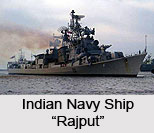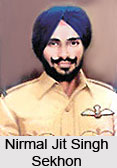 Warfare broke out between India and Pakistan on 03 Dec 1971. The dusk hours of 03 December turned out to be the beginning of a new era for the Indian Navy. On the very night the aggression began, with Pakistan bombing several airfields. Indian Navy Ships `Rajput` and `Akshay` were leaving Vishakapatnam harbour when they obtained a sonar contact. They fired several vigorous charges, and proceeded on their mission when there was no further evidence of a submarine`s presence. Thereafter a loud explosion was heard rattling windows panes off the Vishakapatnam beach. The Pakistani submarine Ghazi had come to misery.
Warfare broke out between India and Pakistan on 03 Dec 1971. The dusk hours of 03 December turned out to be the beginning of a new era for the Indian Navy. On the very night the aggression began, with Pakistan bombing several airfields. Indian Navy Ships `Rajput` and `Akshay` were leaving Vishakapatnam harbour when they obtained a sonar contact. They fired several vigorous charges, and proceeded on their mission when there was no further evidence of a submarine`s presence. Thereafter a loud explosion was heard rattling windows panes off the Vishakapatnam beach. The Pakistani submarine Ghazi had come to misery.
The Indian Navy`s aircraft carrier and her aircraft played a decisive role in the Eastern theatre of the war. The Seahawk and Alize squadrons ruined chaos on vital installations in East Pakistan. Very shortly, the Indian Navy`s Eastern task force was in complete control of the sea and the surrounding air space. Pakistani troops, desperate to escape, sought to use merchant ships for military purposes. Four Pakistani tugs, the merchant ship Baquir, and a Liberian ship were hijacked and escorted to Indian ports. Many others were captured. Moonless nights were selected for the missile boat attack on Karachi harbour. The attack was one of the historic moments of the Indian Navy`s victory and remains engraved in naval memory.
The only Indian ship lost during the 1971 operations was the frigate INS Khukri. Lieutenant General Niazi signed the Instrument of Surrender on 16 December 1971.
 Role of Indian Air force
Role of Indian Air force
For some weeks in November, both Indian and Pakistan governments protested violations of national airspace along the western border, but above ground conflict between the respective air arms began in deep on 22 November, above full-scale warfare between India and Pakistan by 12 days. At 14:49 hours, four Pakistani Sabres strafed Indian and Mukti Bahini positions in the Chowgacha MOR area, and 10 minutes later, while occupied on a third strafing run, four Gnats from No. 22 Squadron, a detachment of which was operating from Dum Dum Airport, Calcutta, intercepted the Sabres.
The IAF had good reason for satisfaction with its showing during the December 1971 conflict. Although Pakistan had initiated the war with preventive air strikes against major forward air bases, the IAF rapidly gained the idea and had thereafter dominated the skies over both fronts. The December 1971 war also meant the gaining of India`s highest award for bravery to the IAF. Flying Officer Nirmal Jit Singh Sekhon, flying Gnats with No. 18 Squadron from Srinagar, was posthumously awarded the Param Vir Chakra.






































